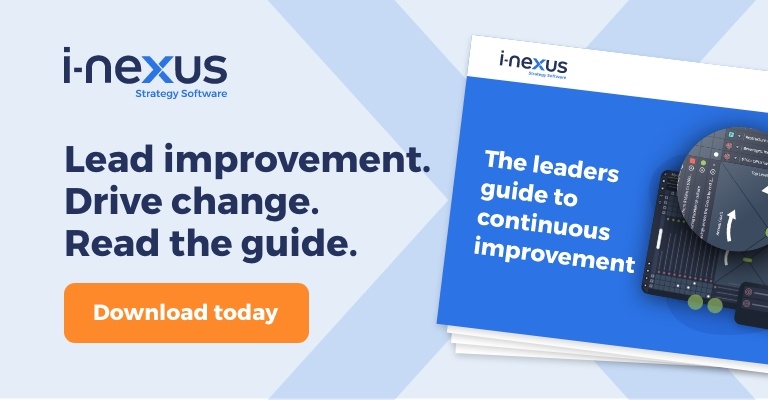Adapt of perish has never been truer in modern business. But if we know we have to adapt, how do we do it? Read on to learn how you can implement a Continual Process Development system into your organization to help with just that.
The adage "adapt or perish" holds truer than ever in business evolution.
Organizations must continuously enhance their operations to thrive in today's competitive landscape.
Enter Continual Process Development—a systematic approach that empowers businesses to adapt, optimize, and flourish.
This comprehensive guide unveils the practical steps, best practices, and real-world insights that will empower you to implement Continual Process Development in your organization successfully.
And if you've not had a chance to read our first part, you can do so below:
What are the key steps to implementing Continuous Process Development?
The concept of Continual Process Development revolves around embracing change as a constant.
It's a journey towards sustained success through incremental improvements in processes.
To embark on this journey, let's explore the key steps for effective implementation.
1. Identify areas for improvement
Before you start, pinpoint the areas that need enhancement.
You can use tools like Value Stream Mapping or Flowcharts to represent your current processes visually. However, in addition to these tools, it's critical to gather employee input.
They have a unique perspective and can offer valuable insights into daily operational challenges.
This step is about identifying inefficiencies and fostering a culture of employee involvement.
2. Gather data to analyze current processes
Data is your compass in this journey.
Invest in data analytics software like Tableau or Power BI to collect and analyze relevant data. Additionally, benchmark your processes against industry standards.
This practice ensures that you're making changes and aligning your organization with best practices in your industry.
3. Engage employees in the improvement process
Involving your team is paramount, but it goes beyond encouraging brainstorming sessions. You should also provide your teams with tools such as Trello to empower them.
These platforms facilitate collaborative idea-sharing and offer efficient ways to experiment with new solutions.
The involvement of employees in the decision-making process enhances innovation.
4. Set up regular reviews and feedback mechanisms
Consistency is key in the world of Continual Process Development. While tools like i-nexus or Jira can help track and manage improvement initiatives, it's essential to establish Key Performance Indicators (KPIs) that align with your business goals.
The crucial addition here is the regular review of these KPIs. Regularly assessing the impact of improvements and making data-driven decisions ensure that your organization is on the right path to successful Continual Process Development.
Best practices for successful Continual Process Development
While the steps for implementing Continual Process Development are essential, adopting best practices is equally crucial. Here are key best practices to ensure the success of your process improvement initiatives:
1. Leadership support
Effective leaders play a pivotal role in driving Continual Process Development. Leaders should champion the process, allocate necessary resources, and support employee involvement.
2. Effective communication
Open and transparent communication is vital. Regularly update your teams about the progress and benefits of improvement initiatives. Effective communication fosters a culture of engagement and reinforces the significance of the changes.
3. Data-driven decisions
Continual Process Development heavily relies on data. Ensure that decisions are based on data analysis. Be open to adjusting strategies based on data-driven insights. Make data a part of your organization's DNA.
4. Training and development
Invest in training and development programs for your employees. Equip them with the skills required for process improvement. This investment will empower your workforce to contribute effectively to the Continual Process Development journey.
5. Empower teams
Give your team ownership over the improvement process. Encourage employees to experiment with new ideas and solutions. This sense of ownership fosters creativity and innovation, driving continuous improvement.
Common challenges in implementing Continual Process Development and how to overcome them
Implementing Continual Process Development is a transformative journey, but it has challenges. Here are some common hurdles organizations face and strategies to overcome them:
1. Resistance to change
Challenge
Employees and management might resist changes to existing processes, fearing disruptions or job insecurity.
Solution
Create a culture that values continuous improvement. Communicate the benefits of change, involve employees in the decision-making process, and provide the necessary training and support to ease the transition.
2. Difficulty in data collection and analysis
Challenge
Gathering and analyzing relevant data can be complex and time-consuming, especially when data sources are disparate.
Solution
Invest in data analytics tools and software that simplify data collection and analysis. Ensure that data collection processes are streamlined and that employees understand the importance of data in driving decisions.
3. Maintaining employee engagement
Challenge
Over time, employee engagement in the improvement process may wane, leading to stagnation.
Solution
Keep the enthusiasm alive by recognizing and rewarding contributions. Create a system for continuous feedback and encourage employees to take ownership of the changes. Highlight the positive impact on their work and the organization.
4. Lack of top management support
Challenge
Without strong leadership backing, the process may lose momentum and face resource constraints.
Solution
Engage top management early in the process. Make them aware of the benefits and align improvements with the organization's strategic goals. Secure their commitment to provide the necessary resources.
5. Inadequate resources
Challenge
Limited budget, time, and skilled personnel can impede the implementation of Continual Process Development.
Solution
Develop a clear business case for the process improvement initiatives, emphasizing the potential returns on investment. Allocate resources strategically and seek ways to optimize resource utilization.
6. Insufficient Training and Clarity of Objectives
Challenge
Employees may struggle to contribute effectively without proper training and clearly defined objectives.
Solution
Prioritize training programs to equip employees with the necessary skills. Ensure that everyone understands the objectives, the expected outcomes, and how their role fits into the bigger picture.
The role of data in implementing continual process improvement
Data plays a pivotal role in the success of continuous process improvement.
It provides the necessary insights, metrics, and evidence for organizations to understand their existing processes and identify areas for enhancement.
Here's a more detailed breakdown of the role of data:
- Data collection
Gathering relevant data is the starting point. Organizations should systematically collect data on various aspects of their processes. This includes cycle times, defect rates, resource utilization, customer feedback, and other relevant information. - Data analysis
Once data is collected, it must be meticulously analyzed. Data analysis tools, such as statistical methods, data visualization tools, and data analytics software like Tableau or Power BI, can help organizations make sense of the information. The analysis involves identifying trends, patterns, bottlenecks, and areas of improvement. - Root cause analysis
Data can help organizations determine the root causes of issues and inefficiencies in their processes. By identifying the underlying reasons for problems, they can develop practical solutions that target the core issues. - Data-driven decision-making
Continuous process improvement is based on making informed decisions. With data as the foundation, organizations can confidently make choices that lead to meaningful enhancements. Decisions regarding process changes, resource allocation, and strategic direction are all supported by data analysis. - Measuring progress
Data enables organizations to measure the impact of process improvements over time. By comparing before-and-after data, they can quantify the effectiveness of their initiatives. Measuring progress helps organizations track their journey toward improved efficiency, cost reduction, and quality enhancement. - Feedback loop
Data creates a feedback loop that informs ongoing process improvement efforts. Regular data collection and analysis allow organizations to assess their processes and adjust their strategies continuously. The feedback loop ensures that improvements are sustained and adapted to changing conditions.
How technology is innovating CPD implementation
Innovative technologies are increasingly becoming essential tools in continuous process improvement.
They expedite the improvement process and enhance the precision and efficiency of interventions.
Here's an exploration of the role of innovative technologies:
- Robotic Process Automation (RPA)
RPA involves using software robots or "bots" to automate repetitive, rule-based tasks. In the context of continuous process improvement, RPA can streamline workflows, reduce human error, and ensure consistency in processes.
This technology is instrumental in scenarios where data entry, data processing, and data transfer tasks are prevalent. Organizations automate these tasks to free up human resources for more valuable and strategic activities. - Artificial Intelligence (AI)
AI is a game-changer for continuous process improvement. AI algorithms can analyze vast datasets with speed and precision, identifying patterns and anomalies that might be challenging for humans to detect.
Machine learning, a subset of AI, can make predictions based on historical data, helping organizations anticipate and prevent process issues. AI-driven predictive maintenance, for instance, can be employed in manufacturing to reduce equipment downtime and increase efficiency. - Internet of Things (IoT)
IoT involves connecting physical devices and objects to the internet, allowing them to collect and transmit data.
IoT is particularly relevant in industries like manufacturing and logistics. With IoT sensors and devices, organizations can monitor the performance of machinery, track inventory, and assess environmental conditions in real-time.
This real-time data is invaluable for detecting issues promptly and optimizing processes. For example, IoT devices can provide real-time tracking of goods and temperature-sensitive cargo in supply chain management.
These technical innovations aren't just tools but transformative enablers of continuous process improvement. They allow organizations to gather, analyze, and act on data more effectively, resulting in faster and more precise process improvements.
Examples of successful CPD implementation
Example 1: Toyota Production System (TPS)
The Toyota Production System is a prime example of Continual Process Development.
It's a philosophy of efficiency, waste reduction, and quality adopted globally.
Toyota remains a leader in the automotive industry by continually improving manufacturing processes.
Example 2: Amazon's Fulfillment Centers
Amazon's fulfillment centers are a testament to continual improvement.
Through data analysis and technological innovations, Amazon constantly enhances its order processing and delivery systems to meet customer demands efficiently.
Example 3: General Electric (GE)
General Electric has embraced Continual Process Development principles for decades.
They focus on efficiency, quality, and innovation, constantly seeking ways to improve manufacturing processes and product quality.
GE's commitment to Continual Process Development has allowed them to stay competitive in diverse industries, from aviation to healthcare.
Example 4: Starbucks Coffee Company
Starbucks, the global coffeehouse chain, implements Continual Process Development to ensure consistent product quality and customer satisfaction.
They regularly refine their coffee-making processes and customer service protocols. Their commitment to improvement has contributed to their success in maintaining a loyal customer base and expanding worldwide.
These examples highlight the versatility of Continual Process Development across various industries, emphasizing the importance of adapting and evolving to meet changing customer needs and market demands.
FAQ - Frequently Asked Questions about CPD
Can you provide examples of companies that failed in implementing continual process development?
While success stories are more common, there have been cases where companies failed due to insufficient commitment, lack of employee involvement, or inadequate data analysis. One example is the downfall of Blockbuster in the face of disruptive technological changes.
What are the common challenges organizations face when implementing Continual Process Development?
Challenges can include resistance to change, difficulty in data collection and analysis, and maintaining employee engagement in the long term. It's essential to address these challenges to ensure successful implementation.
Can you provide examples of industries where Continual Process Development has been particularly beneficial?
Industries such as manufacturing, healthcare, software development, and customer service have significantly benefited from Continual Process Development. It's adaptable to various sectors.
What typical roadblocks hinder the successful implementation of Continual Process Development?
Common roadblocks may include needing more top management support, inadequate resources, insufficient training, and unclear objectives. Overcoming these roadblocks is crucial.
How can organizations maintain momentum in Continual Process Development over the long term?
Sustaining momentum requires a culture of continuous improvement, regular reviews, and reinforcement of the benefits achieved. It's about making it a part of the organizational DNA.
What key performance indicators (KPIs) are used to measure the impact of Continual Process Development?
Common KPIs include cost savings, reduction in process cycle time, improved product quality, and customer satisfaction. These KPIs align with the goals of process improvement.
What is the role of data in Continual Process Development, and how can organizations effectively leverage it for improvement?
Data is crucial in Continual Process Development. It provides insights into process performance, identifies areas for improvement, and supports data-driven decision-making. Organizations can leverage data by collecting it consistently, analyzing it for trends, and using it to inform process changes.
How does employee involvement impact the success of Continual Process Development, and how can organizations foster a culture of employee engagement?
Employee involvement is a cornerstone of success. Engaged employees often provide valuable insights and are more likely to embrace change. Organizations can foster employee engagement through transparent communication, recognizing and rewarding contributions, and involving employees in decision-making.
What are some examples of innovative technologies that can complement Continual Process Development efforts in modern organizations?
Innovative technologies like robotic process automation (RPA), artificial intelligence (AI), and the Internet of Things (IoT) can complement Continual Process Development. These technologies can automate tasks, provide real-time data, and enhance decision-making.
How does leadership support impact the implementation of Continual Process Development, and what are the qualities of an effective leader in this context?
Leadership support is pivotal. Effective leaders set the tone, allocate resources, and promote a culture of continuous improvement. Qualities of an effective leader in Continual Process Development include vision, data-driven decision-making, and the ability to empower teams.
Are there any international standards or frameworks organizations can follow to align their Continual Process Development efforts with global best practices?
International standards and frameworks exist, such as ISO 9001 for quality management and ISO 14001 for environmental management. These standards provide guidelines and best practices for organizations to enhance their Continual Process Development initiatives.
Moving forward
Continuous process improvement isn't just a trend; it's a philosophy that resonates with the ever-evolving nature of business, in a world where change is the only constant, organizations that embrace Continual Process Development position themselves for long-term prosperity.
Your organization can thrive and lead in an ever-competitive landscape by identifying areas for improvement, harnessing the power of data, engaging employees in the transformation process, and maintaining a commitment to progress.
As the business landscape continues to evolve, Continual Process Development is your compass for navigating the challenges and opportunities that come your way. It's your key to unlocking improved efficiency, reduced costs, and enhanced quality.
Whether you draw inspiration from Toyota's renowned production system, Amazon's relentless commitment to data-driven improvements, or countless other successful examples, the essence of Continual Process Development remains the same: adapt, optimize, and flourish.
With effective leadership support, transparent communication, data-driven decision-making, a commitment to training and development, and a culture of innovation, your organization can overcome challenges and seize the countless benefits of Continual Process Development. The real-world examples, best practices, and insights provided here provide a comprehensive guide to empower you on this transformative journey.
To learn more about how you can guide your team's efforts, download our leadership eBook:
Read more about operational excellence and related tools with our content below:
- Choosing between Lean vs. Six Sigma: which is right for you?: Lean and Six Sigma dominate conversations around continuous improvement - but how similar are they? Find out their differences and understand what fits your organization best with our guide.
- The ultimate continuous improvement jargon buster: Your guide to the many names, terms, acronyms, and phrases used when talking about delivering process improvement.
- 10 challenges facing the pharmaceutical industry in 2024: Pharmaceuticals are one of the most vital in the world, providing life-saving medicines and treatments to millions, but it's full of strategy execution challenges. Here's what that looks like.
About the author
James Milsom is Head of Marketing at i-nexus. As Head of Marketing, his drive is to raise awareness and understanding of the challenges facing enterprises in delivering strategic objectives and transformation amidst changing markets and the obstacles traditional tools and methods present leaders.
If you’d like to talk strategy, contact James at james.milsom@i-nexus.com or connect with him on LinkedIn for the latest insights.



